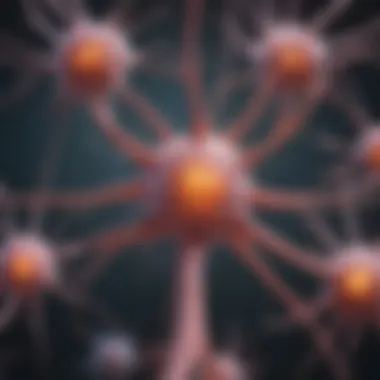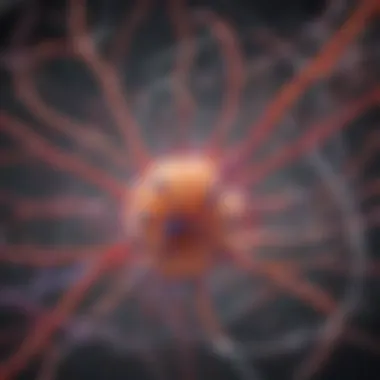Understanding the Pathophysiology of Lewy Body Dementia


Research Overview
Summary of Key Findings
Lewy Body Dementia (LBD) is marked by the presence of Lewy bodies, which are abnormal clumps of protein that develop inside nerve cells. The main proteins involved include alpha-synuclein and ubiquitin. These proteins can disrupt normal cell function, leading to neurodegeneration.
Research indicates that the accumulation of Lewy bodies correlates with various cognitive impairments and motor dysfunctions. Patients may experience hallucinations, fluctuations in attention and alertness, and Parkinsonian symptoms. Each of these manifestations suggests different areas within the nervous system are affected.
Importance of the Research
Understanding the pathophysiology of LBD holds critical value for several reasons. Notably, it assists in distinguishing LBD from other forms of dementia such as Alzheimer's disease. Accurate diagnosis is paramount in managing patients effectively. Research into LBD also sheds light on therapeutic interventions. The findings could lead to potential treatments targeting protein aggregation, offering hope to patients and their families. By identifying these mechanisms, researchers aim to develop strategies to halt or slow progression of the disease, enhancing quality of life for individuals affected.
Methodology
Study Design
Studies concerning LBD typically utilize a mix of observational and clinical studies to examine the relationships between clinical symptoms and biological markers. Cross-sectional studies are common for understanding prevalence and clinical variability. Longitudinal studies may track changes over time, providing insights on disease progression.
Data Collection Techniques
Research often employs a combination of neuroimaging, such as MRI and PET scans, alongside cognitive assessments. Patient histories and clinical evaluations are critical for accumulating data. Biomarkers found in cerebrospinal fluid and blood samples can also be crucial to understanding the biochemical pathways involved. Additionally, randomized controlled trials are conducted to gauge the effectiveness of various therapeutic approaches.
Intro to Lewy Body Dementia
Lewy Body Dementia (LBD) is an intricate and multifaceted neurodegenerative disorder. Understanding its pathophysiology provides essential insights for both diagnosing and managing this complex condition. LBD's unique features diverge from other forms of dementia, making it crucial to appreciate how its symptoms manifest and evolve over time.
Delving into the specifics of LBD is significant not only for researchers but also for clinical practitioners. The nuances embedded within its pathology can influence treatment options and care strategies. Additionally, recognizing the overlap with other neurodegenerative diseases, such as Alzheimer's and Parkinson’s disease, underscores the complexity inherent to LBD.
The following sections will provide an overview and epidemiological insights about LBD, paving the way for a thorough exploration of its neurobiological underpinnings.
Definition and Overview
Lewy Body Dementia is classified as one of the most common types of progressive dementia, alongside Alzheimer’s disease and vascular dementia. It is characterized by the presence of Lewy bodies, which are abnormal protein aggregates predominantly composed of alpha-synuclein. These inclusions disrupt normal cellular function and lead to neuronal death.
Key clinical features include fluctuating cognition, recurrent visual hallucinations, and parkinsonism. Unlike typical Alzheimer’s, patients may exhibit varying levels of alertness and attention throughout the day. The convergence of cognitive decline with physical symptoms often complicates accurate diagnosis, as many signs overlap with other neurodegenerative disorders.
Epidemiology
The prevalence of Lewy Body Dementia varies by demographic factors. It is estimated that around 10-15% of dementia cases are attributed to LBD. It primarily affects older adults, with the average onset occurring in the 70s. However, cases in younger individuals have been documented. Regionally, variations exist, with higher incidences reported in certain populations.
Gender differences are also notable; men tend to be more affected than women. Additionally, risk factors for developing LBD include genetic predispositions, as well as a history of Parkinson’s disease. Recent studies suggest that LBD may develop earlier in individuals with vascular issues or those exposed to certain environmental toxins.
Understanding these epidemiological trends is key in recognizing the broader implications of this disorder in geriatric populations. Continued research is essential to uncover the precise mechanisms driving these patterns, and promote improved therapeutic interventions.
Understanding Neurodegeneration
The understanding of neurodegeneration is pivotal in the context of Lewy Body Dementia. This topic encapsulates various processes that lead to the progressive loss of structure and function of neurons. It is critical to grasp how these mechanisms interconnect, thereby facilitating insights into Lewy Body Dementia’s pathology and potential therapeutic strategies. By investigating neurodegeneration, researchers and clinicians gain a clearer picture of symptomatology, diagnosis, and prospective interventions.
Mechanisms of Neurodegeneration
Neurodegeneration in Lewy Body Dementia involves intricate mechanisms that affect neural circuits. These include:
- Oxidative stress, which damages cellular components, contributing to neuronal death.
- Mitochondrial dysfunction that impairs energy metabolism, leading to cellular apoptosis.
- Neuroinflammation, which exacerbates neuronal loss and can cause further cognitive decline.


Understanding these elements enables the medical community to identify specific targets for treatment. For example, addressing oxidative stress and neuroinflammation may offer pathways for developing neuroprotective strategies.
Role of Protein Aggregation
α-Synuclein in Lewy Bodies
The presence of α-synuclein in Lewy bodies serves as a hallmark of Lewy Body Dementia. Its characteristic lies in the susceptibility to misfolding, which catalyzes a cascade of neurodegeneration processes. The aggregation of α-synuclein into insoluble fibrils ultimately contributes to neuronal toxicity. Its role in establishing neurodegeneration makes it a focal point in research. Specifically, targeting α-synuclein could offer significant strategies for halting or reversing the disease progression, which is why it receives significant attention in the literature.
Impact of Protein Misfolding
Protein misfolding extends beyond α-synuclein to a broader spectrum of proteins linked with neurodegenerative disorders. The misfolding process leads to cellular dysfunction and neuro-inflammation. The impact of protein misfolding in the context of Lewy Body Dementia illustrates how aberrant protein conformations can induce cell death pathways. This understanding underlines the significance of identifying drugs that can stabilize protein structures. By potentially preventing misfolding, novel therapies can arise, which may improve outcomes for individuals afflicted by Lewy Body Dementia.
Understanding the pathways of neurodegeneration and the role of protein aggregation are crucial in developing effective therapeutic approaches for Lewy Body Dementia.
Core Pathophysiological Features
Understanding the core pathophysiological features of Lewy Body Dementia (LBD) is crucial in comprehending how this disorder impacts the brain and manifests in various symptoms. These features reveal the intricate workings of neurodegeneration and the nature of neurochemical disruptions that occur in affected individuals. Addressing these elements can aid clinicians and researchers alike in creating more effective diagnostic and therapeutic strategies.
Cognitive Decline Mechanisms
Cognitive decline in Lewy Body Dementia arises from multiple mechanisms that are interlinked with neurodegenerative processes. One of the primary factors is the disruption of cholinergic function, which is essential for memory and learning. Studies show that loss of cholinergic neurons contributes significantly to cognitive deficits in LBD.
Another relevant aspect is the accumulation of α-synuclein in the brain. This protein aggregation leads to cellular dysfunction, triggering neuroinflammation and synaptic impairment. Simply put, as α-synuclein aggregates form Lewy bodies, the surrounding neural environment becomes toxic, ultimately resulting in neuronal death. Consequently, cognitive decline becomes pronounced, affecting decision-making, attention, and visual-spatial abilities.
"Cognitive decline mechanisms in Lewy Body Dementia illustrate the complexity of neural pathways involved and underline the importance of early detection."
Motor Symptoms Pathways
Motor symptoms in Lewy Body Dementia share characteristics with Parkinson’s disease, primarily due to overlapping pathophysiological processes. A significant factor in this convergence is the degeneration of dopaminergic pathways. This degeneration leads to symptoms such as tremors, rigidity, and bradykinesia. Research highlights that the loss of dopaminergic neurons in the substantia nigra is a key contributor to these motor impairments.
Moreover, the interactions between dopaminergic and cholinergic systems complicate motor control further. The intricate balance of neurotransmitter systems can result in phenomena such as motor fluctuations. People with LBD may experience variable motor function, presenting challenges in treatment and management.
Visual Hallucinations and Perceptual Disturbances
Visual hallucinations are a hallmark of Lewy Body Dementia. These disturbances occur due to alterations in visual processing and neural connectivity related to visual cortex dysfunction and dopaminergic activity. Studies indicate that the interactions between cholinergic and dopaminergic systems play a significant role in these perceptual issues. The imbalance may lead to misinterpretation of visual stimuli, resulting in vivid and distressing hallucinations.
In addition, perceptual disturbances often manifest alongside cognitive decline. Altered perception can exacerbate feelings of confusion and anxiety, further complicating the clinical picture. Addressing these symptoms often demands careful adjustments in therapeutic regimens to mitigate distress while ensuring cognitive support.
In summary, understanding the core pathophysiological features of Lewy Body Dementia enhances our knowledge of its cognitive, motor, and perceptual implications. Each feature is interconnected and emphasizes the necessity for a comprehensive approach to diagnosis and treatment. Further research into these mechanisms is vital to developing more effective interventions that target the underlying causes of this complex disorder.
Neuroanatomical Changes
Neuroanatomical changes play a crucial role in understanding Lewy Body Dementia. This section explores how the physical alterations in brain structure correlate with the symptoms observed in patients. Understanding these changes can enhance our comprehension of disease progression, potentially informing effective treatment strategies. The identification of specific brain regions affected by Lewy bodies provides insight into the cognitive and motor symptoms characterized by the disorder.
Regions Affected by Lewy Bodies
Lewy bodies primarily manifest in several critical regions of the brain. The substantia nigra is notably affected, impacting dopamine-producing neurons. This degeneration is closely linked to the motor symptoms typical of Lewy Body Dementia, such as rigidity and bradykinesia. The cortex, particularly the temporal and occipital lobes, shows significant changes as well, contributing to cognitive decline and visual hallucinations.
Other areas include the amygdala and hippocampus, where alterations can lead to emotional disturbances and memory issues. The widespread distribution of Lewy bodies across these regions indicates the multifaceted nature of the disease and its complex impact on various neuroanatomical structures.
A detailed understanding of these affected regions can provide context for the diverse symptoms presented in patients.
Impact on Neurotransmitter Systems
Lewy Body Dementia also involves significant disruptions in neurotransmitter systems, which can amplify cognitive and physical symptoms. The two neurotransmitter systems of interest are the dopaminergic and cholinergic systems.


Dopaminergic System
The dopaminergic system is crucial in regulating movement and coordination. In individuals with Lewy Body Dementia, the loss of dopamine-producing neurons leads to a range of motor deficits. The key characteristic of this system is its influence on smooth and controlled movement. The beneficial aspect of focusing on the dopaminergic system in this article is its direct relationship with symptoms like tremors and stiffness.
However, there are disadvantages as well, such as the limited effectiveness of current treatments aimed at this system. The unique feature of the dopaminergic system is its susceptibility to neurodegenerative processes leading to observable motor symptoms. Understanding this can aid in developing targeted therapies which may offer hope for patients.
Cholinergic System
The cholinergic system, on the other hand, is significantly involved in cognitive functions such as memory and attention. In Lewy Body Dementia, a decrease in cholinergic activity is common, leading to pronounced cognitive deficits. The key characteristic that makes this system relevant to our article is its role in modulating neuronal communication essential for cognition.
While current therapies targeting this system have shown some promise, the magnitude of improvement varies among patients. The unique feature of the cholinergic system lies in its delicate balance, which when disrupted, exacerbates symptoms. This characteristic highlights the importance of cholinergic modulation in crafting comprehensive treatment approaches within this clinical framework.
Diagnostic Challenges
The diagnostic challenges associated with Lewy Body Dementia are significant due to its overlapping symptoms with other neurodegenerative disorders. Accurate diagnosis is critical for effective management and treatment. One main issue is the variability of symptoms, which can often lead to misdiagnosis. Healthcare providers must differentiate between Lewy Body Dementia, Alzheimer's Disease, and Parkinson's Disease as they share many clinical features. Without a clear distinction, patients may not receive optimal care or appropriate therapies.
Furthermore, the lack of definitive tests for Lewy Body Dementia complicates the process. Clinical evaluation typically involves gathering detailed patient histories and assessing cognitive and motor function. Given the diverse presentation of symptoms, these assessments can yield inconsistent results. Therefore, clinicians must remain vigilant and employ a combination of assessment methods to increase diagnostic accuracy.
"Understanding the nuances of the diagnosis is essential for timely and effective intervention in Lewy Body Dementia."
Clinical Assessment Methods
Clinical assessment for Lewy Body Dementia involves a multi-faceted approach. Physicians generally conduct cognitive tests to evaluate memory, attention, and executive function. Common assessments include the Mini-Mental State Examination and the Montreal Cognitive Assessment. Additionally, thorough neurological exams are crucial to inspect for motor symptoms such as tremors, rigidity, and bradykinesia.
It is important to note that context matters for accurate assessment. Patient interviews can provide insights into fluctuations in cognition, which is a hallmark of Lewy Body Dementia. Family reports of changes in behavior, sleep disturbances, or visual hallucinations also play a critical role in shaping the diagnostic picture.
Role of Neuroimaging
Neuroimaging serves as an essential tool in the diagnostic process of Lewy Body Dementia. It allows for detailed visualization of the brain's structure and function, aiding in differentiating this condition from other dementia types. While neuroimaging cannot provide a definitive diagnosis on its own, it can support clinical assessments through various techniques.
CT and MRI Techniques
Computed Tomography and Magnetic Resonance Imaging are widely used techniques in the evaluation of dementia. CT scans are beneficial for ruling out other causes of cognitive decline, such as strokes or tumors. Their speed and accessibility make them a favorable option in emergency settings. MRI, on the other hand, offers higher resolution images and can detect subtle changes in brain structure indicative of neurodegenerative diseases.
One key characteristic of CT is its lower cost and faster execution compared to MRI. However, MRI provides more comprehensive information about brain tissue and possible areas affected by Lewy bodies. The disadvantage is that MRI is often not available as quickly as CT, and it may not be suitable for all patients due to claustrophobia or other contraindications.
PET Imaging in Diagnosis
Positron Emission Tomography is another neuroimaging method that can be crucial for diagnosing Lewy Body Dementia. It allows for the assessment of metabolic activity in the brain, highlighting areas of decreased function. An important aspect of PET imaging is its ability to differentiate between Lewy Body Dementia and other variations of dementia based on brain glucose metabolism patterns.
The major advantage of PET imaging is its sensitivity to changes in brain activity, effectively identifying the metabolic decline associated with Lewy Body Dementia. However, it is a more expensive procedure and is less accessible than CT and MRI. Moreover, the interpretation of PET scans can be complex and requires specialized expertise, which may not be readily available in all healthcare settings.
Pathophysiological Innovations
Pathophysiological innovations represent a crucial area of exploration in understanding Lewy Body Dementia (LBD). The advancements in this field are providing insights that illuminate the complex nature of this disorder. As research progresses, new findings shed light on the specific biochemical and molecular changes that underlie LBD. These innovations not only enhance our comprehension of the disease mechanisms but also refine the diagnostic criteria and therapeutic strategies, enabling more effective management of patients.
Emerging Research Findings
Recent studies have focused on several aspects of Lewy Body Dementia that offer promise for future understanding and treatment. Researchers have been uncovering the roles of various proteins involved in the formation of Lewy bodies and their influence on neuronal function. For instance, the accumulation of alpha-synuclein remains a pivotal area of investigation.
Understanding how these proteins interact with neuronal pathways could lead to breakthroughs in the molecular understanding of LBD. Moreover, several studies have examined the potential of advanced imaging techniques, which might contribute to earlier and more accurate diagnoses.
In addition, new therapeutic targets are being explored. For example, studies have shown the potential serotonin's role in cognitive function and mood regulation in patients with LBD. As we gain more insights, we can develop targeted interventions that may slow progression or alleviate symptoms.
"Understanding the pathophysiological innovations is essential for both advancing research and enhancing clinical practices."


Biomarkers in Lewy Body Dementia
The identification of reliable biomarkers in Lewy Body Dementia is of significant interest to researchers and clinicians alike. Biomarkers can provide critical information for diagnosis and prognosis. They allow for a more nuanced understanding of disease progression and can help in the stratification of patients based on the severity of their condition.
Currently, some promising candidates for biomarkers include specific proteins associated with cell stress and neurodegeneration. For instance, elevated levels of neurofilament light chain (NfL) in the cerebrospinal fluid may indicate neurodegenerative processes at work. Another area of interest is the exploration of imaging biomarkers, including PET scans, which identify amyloid and tau pathologies that may co-occur with Lewy bodies.
The development and validation of these biomarkers are essential as they can lead to more personalized treatment strategies. Utilizing biomarkers will also enhance clinical trial designs, enabling researchers to assess the effects of new therapies more effectively.
In summary, exploring pathophysiological innovations, emerging research findings, and biomarkers is vital in understanding Lewy Body Dementia. This focus not only contributes to academic knowledge but directly impacts patient care and therapeutic options.
Therapeutic Approaches
Understanding therapeutic approaches for Lewy Body Dementia (LBD) is crucial to improving the quality of life for affected individuals. These strategies aim to alleviate symptoms and slow the progression of the disease, ultimately enhancing patient care. Current treatments often focus on symptom management, while future directions hold the promise of innovative therapies that address underlying pathophysiological changes.
Current Treatment Strategies
Current treatment strategies for LBD often involve a combination of pharmacological and non-pharmacological interventions. Medications primarily used include antipsychotics, antidepressants, and cholinesterase inhibitors.
- Antipsychotics such as quetiapine and clozapine may help manage severe hallucinations and behavioral disturbances, though they must be used with caution due to potential side effects such as exacerbating motor symptoms.
- Cholinesterase inhibitors like rivastigmine have shown effectiveness in improving cognitive functions, potentially addressing some of the cognitive decline seen in LBD patients.
- Non-pharmacological strategies include occupational therapy, cognitive stimulation, and support groups, which can significantly enhance social interaction and coping mechanisms for patients and caregivers alike.
These strategies emphasize personalized care, as patient responses can vary widely. Monitoring and adjusting treatment plans are essential to maximize patient outcomes.
Future Directions in Therapy
Future directions in therapy for Lewy Body Dementia emphasize a deeper understanding of the disease and the development of novel treatments that target its underlying mechanisms.
Neuroprotective Agents
Neuroprotective agents represent a promising area of research. These agents aim to protect neurons from degeneration and offer various mechanisms of action, such as reducing oxidative stress and inflammation.
- One of the key characteristics of neuroprotective agents is their ability to slow down cellular damage. This capability is essential in LBD because it may mitigate the progression of motor and cognitive symptoms.
- Studies have suggested that certain neuroprotective agents, like N-acetylcysteine, have shown potential in preclinical models of neurodegeneration, making them a focal point for ongoing research.
The unique feature of neuroprotective agents lies in their potential to enhance neuronal resilience. However, challenges remain in effectively translating these findings into clinical practice, as not all candidates have proven effective in human trials.
Immunotherapies
Immunotherapies also emerge as a critical focal point in treating LBD. These therapies seek to harness the immune system to combat protein aggregation, which is central to LBD pathology.
- A key characteristic of immunotherapies is their specificity. They can be designed to target alpha-synuclein, the primary protein implicated in Lewy body formation. This specificity may reduce systemic side effects seen with general treatments.
- Ongoing trials have put forth immunotherapeutic agents that may slow the progression of LBD by clearing aggregated proteins from the brain.
The unique feature of immunotherapies in LBD is their targeted mechanism of action. Nonetheless, further studies are required to understand their long-term effects and determine optimal administration routes.
In summary, therapeutic approaches for Lewy Body Dementia continue to evolve. Current strategies focus on symptom management, while future directions underscore the potential of neuroprotective agents and immunotherapies. Research into these areas is vital for offering a more comprehensive treatment landscape for affected individuals.
Culmination
By summarizing key points, we remind the audience of significant aspects such as the role of protein aggregation, neuroanatomical changes, and the challenges associated with diagnosis. Highlighting these elements aims to reinforce their relevance in clinical practice and research endeavors. Moreover, understanding these parameters may assist in refining therapeutic strategies, potentially improving patient outcomes.
In a broader sense, acknowledging the complexities of Lewy Body Dementia invites ongoing dialogue and exploration in the field of neurology. It is essential that research continues to delve into the pathophysiological aspects of this disorder, paving the way for innovative therapies and interventions. This conclusion serves as a call to action for the scientific community to continuously seek deeper insights into Lewy Body Dementia.
Summary of Key Points
- Lewy Body Dementia involves the accumulation of abnormal protein structures known as Lewy bodies, primarily composed of alpha-synuclein.
- The neurodegenerative processes contribute to cognitive decline, motor symptoms, and visual hallucinations, creating a diverse clinical presentation.
- Neuroanatomical changes in regions such as the cortex and subcortex impact neurotransmitter systems, particularly the dopaminergic and cholinergic systems.
- Diagnostic challenges persist due to overlapping symptoms with other dementias, necessitating advanced imaging techniques for accurate assessment.
- Current therapeutic approaches focus on symptomatic relief, while future strategies may enhance neuroprotection and target protein aggregation.
Implications for Future Research
Future research on Lewy Body Dementia holds the promise of unveiling novel insights into the disease's underlying mechanisms. Exploring the following areas may significantly impact the field:
- Investigation of Biomarkers: Identifying specific biomarkers can aid in early diagnosis and better understanding of disease progression.
- Innovative Therapeutics: Research into neuroprotective agents and immunotherapies may provide new avenues for treatment, addressing the root causes rather than just the symptoms.
- Longitudinal Studies: Large-scale, multi-site studies can yield valuable data on patient demographics, progression, and treatment efficacy.
- Genetic and Environmental Factors: Examining the interplay between genetic predisposition and environmental influences will help unravel the complexities of this disorder.
Understanding these aspects not only enhances the knowledge base but also guides clinical practice and potential health policy implications. The convergence of evolving research methodologies and collaborative efforts among interdisciplinary teams is essential for tackling the challenges posed by Lewy Body Dementia.



